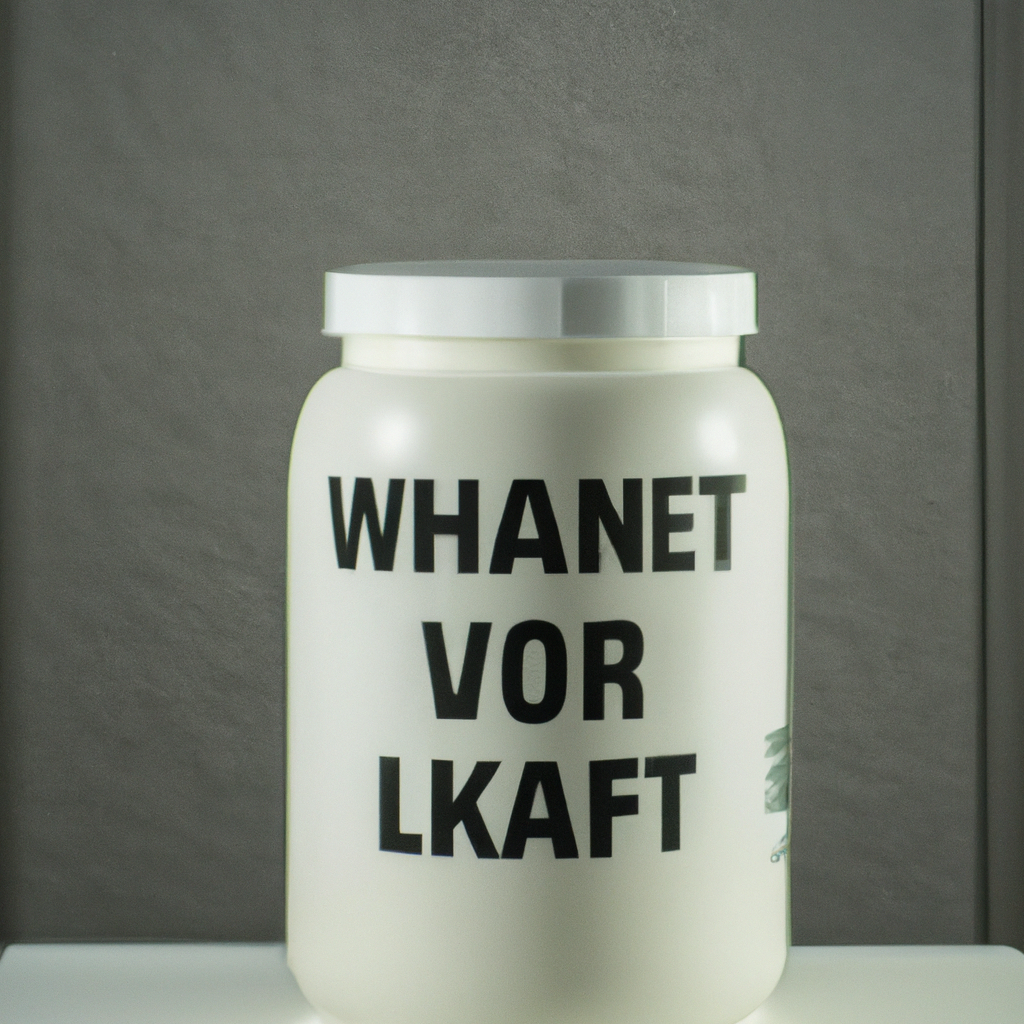The world of fitness and nutrition is constantly evolving, and with so many options available to us, it can be hard to know how to choose the right supplements. One such supplement that has become increasingly popular in recent years is whey protein. Whether you’re a seasoned gym-goer or just starting out on your fitness journey, chances are you’ve heard of this high-protein powder. But what happens once you’ve opened your tub of whey protein? How long is it actually good for? Today, we’re answering the question on everyone’s minds: “Wie lange ist whey protein nach dem öffnen haltbar?
1. Unlocking the Mystery: How Long Does Whey Protein Last After Opening?
Whey protein is a popular dietary supplement that helps individuals build muscle, improve athletic performance, and support weight loss. However, when we talk about how long does whey protein last after opening, there’s no definitive answer.
The longevity of whey protein depends on various factors such as exposure to light, heat, moisture, and contaminants. Hence, it’s essential to store it correctly to extend its shelf life and maintain its nutritional value.
- Storage Tips:
- Keep it in a cool, dry place:
- Use an airtight container:
To make your whey protein last after opening, here are some handy tips.
High temperatures and humidity can affect the protein structure and cause it to spoil. Hence, store it in a cool, dry area away from sunlight, heat sources, and moisture.
Sealing the protein powder tightly with its original packaging or transferring it to an airtight container prevents moisture and air exposure, which can cause clumping, insect infestation, and bacterial growth.
Over time, exposure to air, moisture, or heat can cause whey protein to lose its meager taste and nutrition, but it rarely goes bad. However, if you notice an unusual odor, flavor, or texture, it’s time to discard it or seek expert advice.
In conclusion, if stored correctly, the dehumidified whey protein powder, once opened, may last for six to twelve months, depending on the brand, packaging, and storage conditions. However, it’s best to check the expiration date or use-by date on the label and consume it before that date. After all, consuming expired food can cause food poisoning and other health hazards.

2. The Shelf Life of Whey Protein: Factors That Affect Its Durability
Whey protein is a popular dietary supplement among fitness enthusiasts and those looking to improve their overall health. However, like all food products, whey protein does have a shelf life. The durability of whey protein depends on various factors, including the processing method, packaging, storage conditions, and the presence of additives.
The processing method of whey protein significantly affects its shelf life. The drying method used to produce whey protein concentrates and isolates determines their stability. They must be dried at the right temperature and time to minimize moisture content, which can lead to spoilage. Whey protein hydrolysates, on the other hand, have better stability due to their pre-digested form, which makes them resistant to bacterial growth.
Packaging is another crucial factor affecting the durability of whey protein. Whey protein packaged in foil bags is protected from the harmful effects of moisture, light, and oxygen, which can cause oxidation and degradation. However, whey protein sold in clear plastic containers or transparent bags is exposed to light that can promote oxidation and degradation, reducing its shelf life.
Storage conditions also affect the shelf life of whey protein. Whey protein should be stored in a cool, dry place away from direct light and heat. High temperatures and moisture can cause whey protein to degrade, leading to the formation of unpleasant odors and off-flavors. Moreover, contact with moisture can increase the growth of bacteria, which can cause spoilage.
The presence of additives also influences the shelf life of whey protein. Some manufacturers include preservatives or stabilizers in their products to improve their shelf life. However, additives can also have adverse effects on the product’s quality, taste, and nutritional value. Consumers should, therefore, read labels carefully and avoid products with additives they are allergic to or may cause harm.
In conclusion, the durability of whey protein depends on several factors, including the processing method, packaging, storage conditions, and additives. Consumers should consider these factors when purchasing whey protein to ensure they get the most out of their supplement. Following the manufacturer’s recommended storage conditions and checking the expiration date can help extend the shelf life of whey protein.
3. Spoiled or Safe? How to Tell If Your Whey Protein Has Gone Bad
Whey protein is a popular supplement among fitness enthusiasts for its ability to help build muscle and aid in recovery after a workout. It’s important to know when your whey protein has gone bad to avoid any negative effects on your health or workout routine.
First, start by checking the expiration date on the packaging. If the date has passed, it’s safest to discard the powder. However, if the protein is still within the expiration date, there are other ways to tell if it has gone bad.
One of the most common signs of spoiled whey protein is a change in smell. If the powder has a rancid or sour odor, it’s likely that the protein has spoiled. Additionally, if you notice any mold or unusual discoloration in the powder, it’s best to throw it out.
Another way to test the safety of your whey protein is by mixing it with water or milk. Spoiled protein may have an off taste or cause gastrointestinal issues such as bloating or nausea. If you experience any discomfort after consuming the protein, it’s a good indication that it’s time to throw it away.
To ensure the longevity of your whey protein, it’s important to store it properly. Keep the powder in a cool, dry place and avoid exposure to moisture or sunlight. Additionally, using an airtight container can help prevent oxidation and prolong the shelf life of the supplement.
In summary, knowing when your whey protein has gone bad is crucial for maintaining optimal health and avoiding any adverse effects on your workout routine. Always check the expiration date, smell, and taste of the protein to ensure it is safe for consumption. Storing the supplement properly can also help extend its shelf life.
4. From Storage to Consumption: Tips to Maximize the Freshness of Whey Protein
Tips to Maximize the Freshness of Whey Protein
Whey protein is one of the most popular supplements for athletes and fitness enthusiasts. Its benefits include promoting muscle growth, aiding in weight loss, and helping with recovery after exercise. However, like all supplements, whey protein has an expiration date, and its freshness can be affected by various factors. Here are some tips to help you maximize the freshness of your whey protein.
1. Buy from a reputable source
When buying whey protein, it’s essential to purchase it from a reputable source that ensures good storage conditions. This helps to ensure that the product is fresh and of high quality. Ideally, you should buy from a supplier who stores their products in a climate-controlled environment and has a fast turnover rate to avoid products going stale.
2. Store properly
After purchasing whey protein, it’s essential to store it correctly to maintain its freshness. Store it in a cool, dry place, away from sunlight and heat. Heat and moisture can cause the protein to deteriorate faster, leading to a lower quality product. You can use airtight containers, like glass jars or plastic containers, to keep the protein fresher for longer.
3. Keep it sealed
It’s essential to keep your whey protein sealed to avoid exposure to air, which can cause it to oxidize and lose its freshness. After opening the product, ensure that you reseal it tightly to reduce exposure to air. Alternatively, you can use airtight containers to maintain its freshness.
4. Don’t mix with liquids until you’re ready
Another way to maximize the freshness of your whey protein is to avoid mixing it with liquids until you’re ready to consume it. When you mix whey protein with a liquid, it can start to break down, and its quality can decline. If you need to mix your protein in advance, store it in the fridge to maintain its freshness.
5. Check for expiration dates
Finally, it’s essential to check the expiration date before consuming your whey protein. Consuming expired protein powder can lead to digestive issues and a reduced quality product. Always ensure that you check the expiration date and consume the product before it expires.
By following these tips, you can maximize the freshness and quality of your whey protein, ensuring that you get the most out of your supplement.
5. Waste Not, Want Not: Ideas for Using Excess or Expired Whey Protein
If you’ve been fitness-minded for a while, there’s a good chance you’ve got a few tubs of whey protein stashed around the house. You might reach for it after a workout, but after a while, you may find yourself drowning in excess or expired powder. Don’t throw it out just yet! There are plenty of ways you can put that whey protein to work.
1. Make your own protein bars:
Making your protein bars is a great way to use up excess whey protein powder. The great thing about homemade protein bars is that you can control the ingredients and flavor to suit your tastes. You can add oats, seeds, dried fruits and nuts to create a perfect pre-workout snack.
2. Fluff up your pancakes:
Whey protein powder makes the perfect addition to pancake batter! Not only does it add a nice texture, it also increases the protein content of the meal, making it more satiating. Instead of flour, try using whey protein powder to make delicious high protein pancakes.
3. Give your milk a health boost:
Whey protein is known for its ability to build and repair muscles after exercise. Add a scoop of whey protein powder to your milk and blend thoroughly for a quick and easy protein-packed shake. You can also try adding whey protein powder to your smoothies for added nutrition.
4. Boost your oatmeal:
Oatmeal is a great breakfast option, but it can be a bit bland on its own. Add some sweetness and protein boost to your oatmeal by adding whey protein powder to it. Cook your oats with milk, add a scoop of whey protein powder and mix until thick and creamy.
5. Make a protein-packed dip:
Whey protein is a great addition to dips, especially if you’re trying to increase your protein intake. Mix whey protein powder with Greek yogurt and some herbs to make a healthy and flavorful dip that can be enjoyed with vegetables, crackers or pita chips.
There are several ways to use whey protein powder, so don’t let excess powder go to waste. Try one of these ideas and see how tasty and nutritious your recipes can be!
6. Weighing the Pros and Cons of Buying in Bulk vs. Small Batches
When it comes to shopping, you may have wondered whether purchasing in bulk or smaller batches is the better choice for you. Both methods have their advantages and disadvantages, and it’s important to weigh each of them carefully to make an informed decision.
Bulk shopping can save you money, as larger quantities are often sold at a lower unit price. This can be particularly beneficial for items you use frequently, such as household essentials like toilet paper or laundry detergent. If you have ample storage space, buying in bulk can also save you time by reducing the number of trips you need to make to the store.
However, there are some downsides to buying in bulk. For example, some purchases may expire before you have a chance to use them, particularly items that are perishable or have a short shelf life. You’ll also need to ensure that you have enough space to store your bulk purchases, which can be challenging if you have limited storage capabilities.
On the other hand, buying in smaller batches can allow you to more easily try new products without committing to a large quantity. This can be particularly useful for items like food or cosmetics, where personal preference plays a large role in choosing the right product. Buying smaller batches can also be more convenient if you have limited storage space, as you’ll only need to purchase what you need when you need it.
However, buying in smaller batches can also be more expensive overall, as the unit price is often higher than bulk purchases. This can add up over time, particularly if you prioritize convenience over cost. Additionally, you may need to visit the store more frequently to restock your supplies, which can be time-consuming.
Ultimately, the decision to buy in bulk or smaller batches depends on your individual needs and priorities. Consider the cost, convenience, and storage requirements of each method, and choose what works best for you. Remember, there is no right or wrong answer – it’s all about finding what works best for you and your lifestyle.
7. How Properly Storing Your Whey Protein Can Save You Money and Boost Your Health Goals
One of the most important aspects of achieving your health goals is to ensure that you are consuming high-quality and nutrient-dense foods. Whey protein powder is an excellent source of protein that can supplement a well-balanced diet and aid in muscle growth and recovery. However, did you know that properly storing your whey protein can also help you save money and reach your health goals more effectively?
Here are some practical tips for storing your whey protein powder that can help you maintain the quality, flavor, and nutritional value of your supplement:
1. Keep it in a cool and dry place: One of the most significant factors that affect the quality of your whey protein is the environment in which it is stored. Exposing your protein powder to heat, humidity, and moisture can lead to spoilage, clumping, and loss of nutrients. Ideally, store your whey protein in a cool and dry place, away from direct sunlight and sources of heat, such as ovens, stovetops, or radiators. A pantry, cupboard, or shelf in a climate-controlled room is ideal.
2. Use an airtight container: Another way to preserve the freshness and integrity of your whey protein powder is to store it in an airtight container. This can prevent moisture, air, and odors from seeping into the powder and causing degradation or contamination. You can use a plastic or glass container with a tight-fitting lid or a sealable bag that can be pressed to remove excess air.
3. Don’t store it in the fridge or freezer: Although refrigeration and freezing may seem like a good way to extend the shelf life of your whey protein, they are not recommended. These conditions can cause condensation and moisture to form on the surface of the powder, leading to clumping, caking, and loss of flavor. Moreover, the temperature fluctuations can affect the protein structure and reduce its bioavailability and digestibility.
4. Avoid using a wet scoop or spoon: If you scoop your whey protein powder with a damp or wet utensil, you risk introducing water or moisture into the container, which can cause the powder to clump or stick together. Always use a dry, clean, and leveled scoop or spoon to measure out your protein, and don’t forget to wipe it with a clean cloth or paper towel after each use.
By following these simple tips for storing your whey protein powder, you can ensure that you are getting the most value and benefits out of your supplement. Not only will you save money by avoiding spoilage and waste, but you will also enjoy the full flavor and nutritional profile of your protein powder, which can help you reach your fitness and health goals more efficiently. In conclusion, the shelf life of whey protein after opening largely depends on the storage conditions and the presence of any contaminants. It’s important to always check the expiry date before purchasing and consuming whey protein. Also, ensure that you store your protein powder in a cool, dry place and avoid exposing it to moisture or heat. With these tips in mind, you can enjoy the benefits of whey protein for a long time. Happy training!



